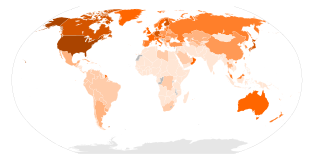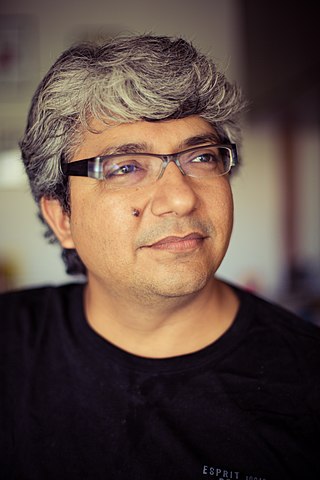
NHK World-Japan is the international arm of the Japanese public broadcaster NHK. Its services are aimed at the overseas market, similar to those offered by other national public-service broadcasters, such as the British BBC, France 24, or the German DW. Contents are broadcast through shortwave radio, satellite, and cable operators throughout the world, as well as online and through its mobile apps. NHK World-Japan is also available on DirecTV channels 322 and 2049. It is headquartered in Tokyo.
Television broadcasts in the United Kingdom began in 1932, however, regular broadcasts would only begin four years later. Television began as a public service which was free of advertising, which followed the first demonstration of a transmitted moving image in 1926. Currently, the United Kingdom has a collection of free-to-air, free-to-view and subscription services over a variety of distribution media, through which there are over 480 channels for consumers as well as on-demand content. There are six main channel owners who are responsible for most material viewed.

Zee TV is an Indian Hindi language general entertainment pay television channel owned by Zee Entertainment Enterprises. It was launched on 1 October 1992, as the oldest privately owned Television channel in India. The defunct and unsuccessful Asia Television Network started earlier.
Television broadcasting in Greece began in 1966, preceded in 1951 by statute 1963 permitting television broadcasting.

Doordarshan is an Indian state-owned public television broadcaster founded by the Government of India, owned by the Ministry of Information and Broadcasting and one of Prasar Bharati's two divisions. As one of India's largest broadcasting organisations in studio and transmitter infrastructure, it was established on 15 September 1959. Doordarshan, which also broadcasts on digital terrestrial transmitters, provides television, radio, online and mobile services throughout metropolitan and regional India and overseas.

Television is one of the major mass media outlets in the United States. In 2011, 96.7% of households owned television sets; about 114,200,000 American households owned at least one television set each in August 2013. Most households have more than one set. The percentage of households owning at least one television set peaked at 98.4%, in the 1996–1997 season. In 1948, 1 percent of U.S. households owned at least one television; in 1955, 75 percent did. In 1992, 60 percent of all U.S. households had cable television subscriptions.
The television industry in India is very diverse and produces thousands of programs in many Indian languages. More than half of all Indian households own a television. As of 2016, the country had over 900 channels of which 184 were pay channels. National channels operate in Hindi and English, in addition to channels in several other languages including Telugu, Tamil, Kannada, Malayalam, Bengali, Marathi, Odia, Punjabi, Assamese, Gujarati, Urdu, Bhojpuri, Kashmiri, Konkani and Haryanvi, among others. The Hindi, Telugu and Tamil language television industries are by far the largest television industries in India.

Sun TV is an Indian Tamil-language general entertainment pay television channel owned by Sun TV Network. It was launched on 14 April 1993. It is the flagship channel of the Chennai-based media conglomerate Sun Group's Sun TV Network. It was founded and is owned by Kalanithi Maran.

Pakistan Television Corporation is the Pakistani state-owned broadcaster founded by the Government of Pakistan, owned by the Ministry of Information and Broadcasting. It was established on 26 November 1964, with a pilot television station established at Lahore.

The Filipino Channel, commonly known as TFC, is a global subscription television network owned and operated by the Philippine media conglomerate ABS-CBN Corporation. Its programming is composed primarily of imported programs produced and distributed by ABS-CBN Entertainment and ABS-CBN News, targeting the Filipino diaspora. Available globally on various television platforms, TFC launched on September 24, 1994, and was the world's first trans-Pacific Asian broadcaster.

The geographical usage of television varies around the world with a number of different transmission standards in use and differing approaches by government in relation to ownership and programme content.

WPSU-TV is a PBS member television station licensed to Clearfield, Pennsylvania, United States, serving West-Central Pennsylvania. Owned by the Pennsylvania State University as part of Penn State Public Media, it is sister to NPR member WPSU and student radio station WKPS. The three stations share studios at Innovation Park on Penn State's University Park campus in State College. WPSU-TV's primary transmitter is located seven miles (11 km) north of Clearfield in Lawrence Township, with a secondary transmitter in Pine Grove Mills, Pennsylvania.
RFD-TV is an American pay television channel owned by Rural Media Group, Inc. The channel features programming devoted to rural issues, concerns and interests. The channel's name is a reference to Rural Free Delivery, the name for the United States Postal Service's system of delivering mail directly to rural patrons. Production and uplinking facilities for RFD-TV are located at 49 Music Square West, Music Row in Nashville, Tennessee. RFD-TV's sister radio channel is Rural Radio on Sirius XM. RFD-TV formerly owned a theater in Branson, Missouri where some variety shows that air on RFD-TV were filmed, as well as the Imus Ranch in Ribera, New Mexico.

Gemini TV is an Indian Telugu language general entertainment pay television channel owned by Sun TV Network. It was launched on 9 February 1995. Gemini TV is the first satellite TV channel in Telugu. The channel's programming consists of serials, films, film-based programs and game shows alongside some reality shows. Gemini TV HD was launched on 11 December 2011.

Satellite Instructional Television Experiment or SITE was an experimental satellite communications project launched in India in 1975, designed jointly by NASA and the Indian Space Research Organization (ISRO). The project made available informational television programs to rural India. The main objectives of the experiment were to educate the financially backward and academically illiterate people of India on various issues via satellite broadcasting, and also to help India gain technical experience in the field of satellite communications.
Lok Sabha TV was an Indian public cable television network channel that offered coverage of central government proceedings and other public affairs programming. Its remit was to make accessible to all the work of the parliamentary and legislative bodies of India. The channel broadcast live and recorded coverage of the Lok Sabha while Rajya Sabha TV covered the sessions of the Rajya Sabha.
Television in Japan was introduced in 1939. However, experiments date back to the 1920s, with Kenjiro Takayanagi's pioneering experiments in electronic television. Television broadcasting was halted by World War II, after which regular television broadcasting began in 1950. After Japan developed the first HDTV systems in the 1960s, MUSE/Hi-Vision was introduced in the 1970s.
DD Chennai, formerly known as DD Madras, is a state-owned television channel telecasting from Doordarshan Kendra, Chennai.

Television in Egypt is mainly received through free satellite, while analog terrestrial represents 41% of total viewers. The Central Agency for Public Mobilisation and Statistics (CAPMAS) said the average time an Egyptian spends watching television a day is 180 minutes, while Egyptian channels recorded 170,000 hours of broadcast in 2019.

Junaid Memon is an Indian film producer and director. He is the founder of Nomad Films Ltd., which produces feature films, commercials, and documentaries. He founded the non-profits ARDEA Foundation and Green TV India, to promote sustainable agriculture among Indian farmers.













